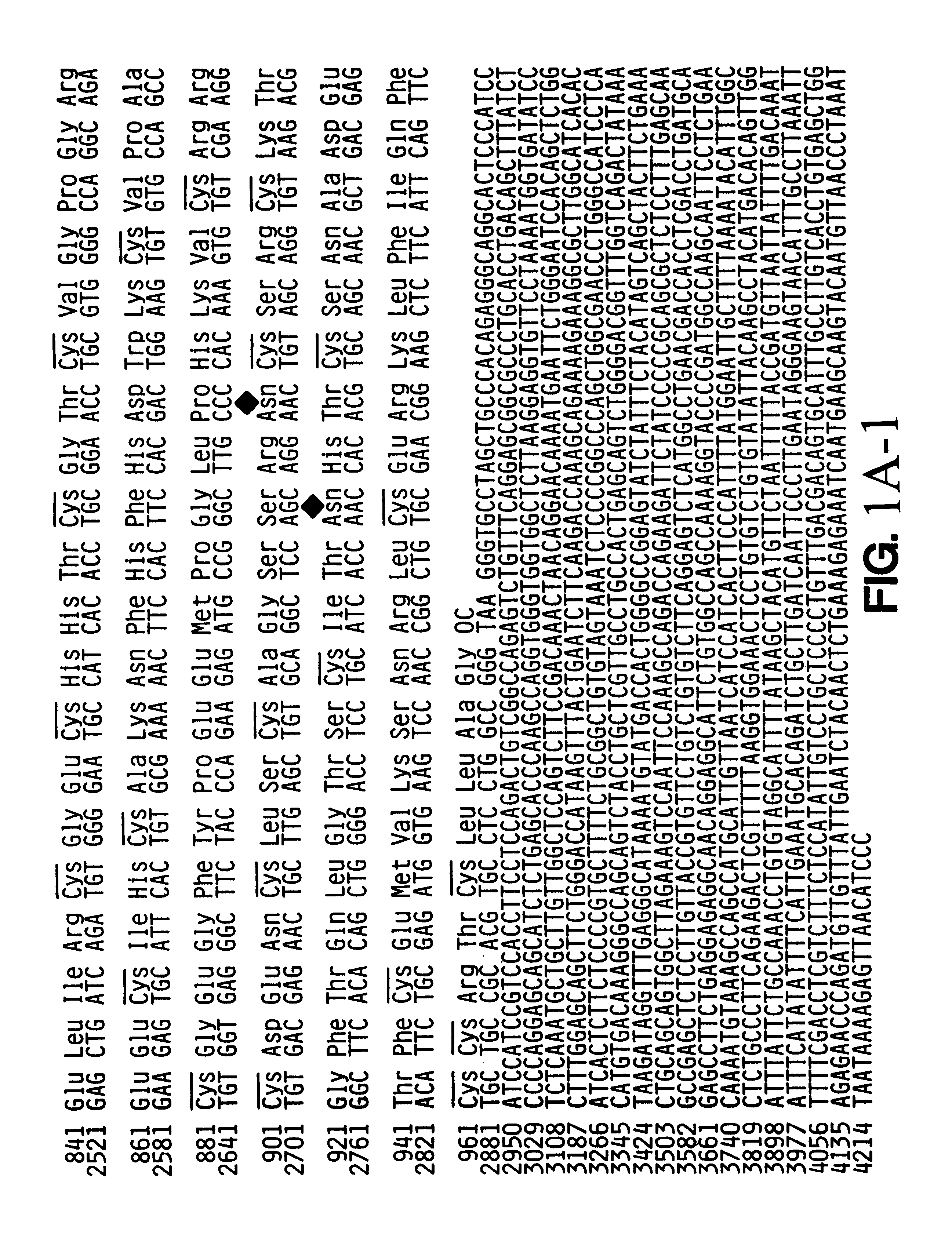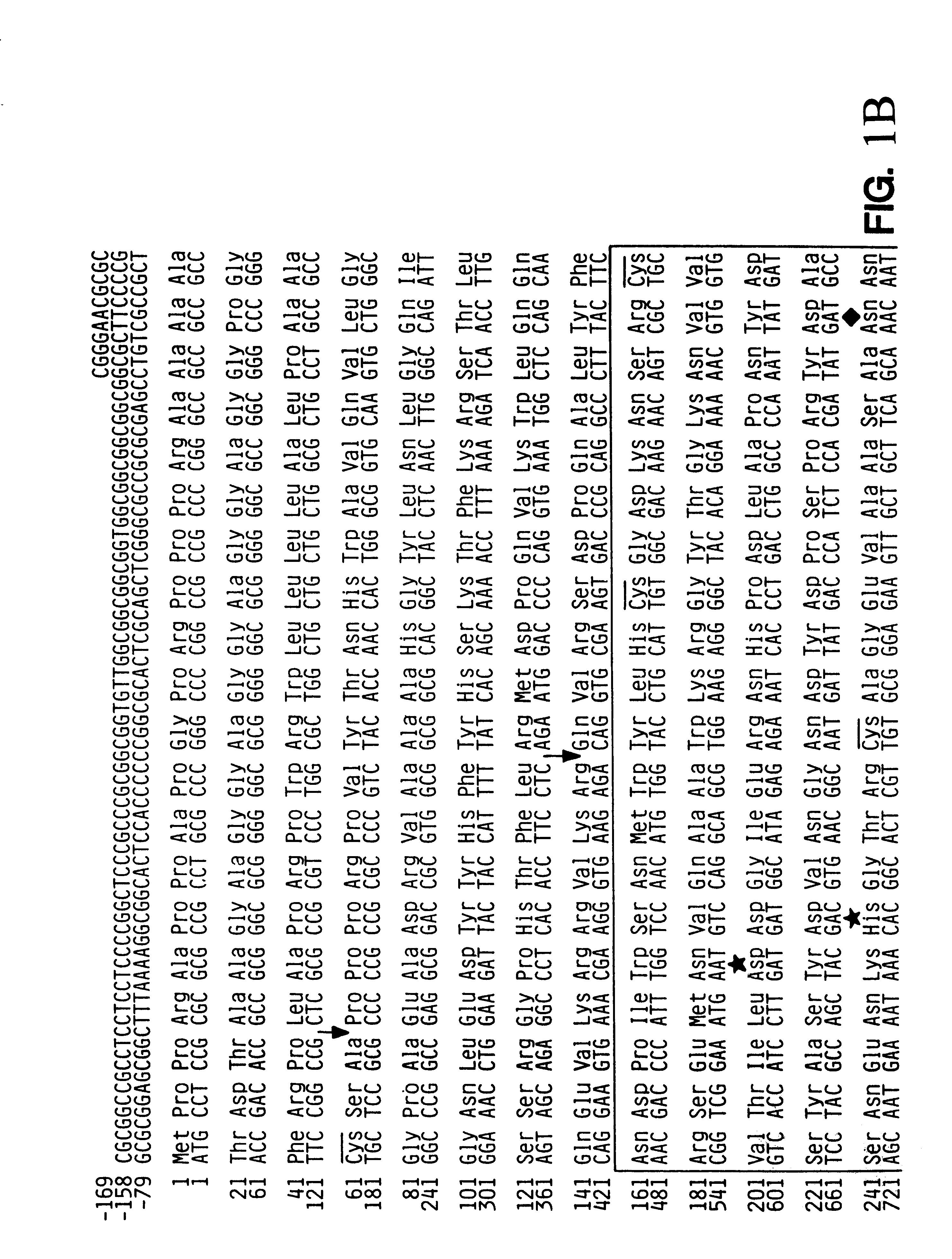Compositions and methods for pace 4 and 4.1 gene and polypeptides in cells
a technology of polypeptides and genes, applied in the field of protein and their production in recombinant host cells, can solve the problems of low specific activity, no bona fide precursor of these candidate activities, and synthesized eukaryotic proteins
- Summary
- Abstract
- Description
- Claims
- Application Information
AI Technical Summary
Problems solved by technology
Method used
Image
Examples
example 2
Structures of PACE 4 and 4.1 Deduced from CDNA Sequences
The full sequence of the PACE 4 cDNA (SEQ ID No: 1)and the encoded protein sequence (SEQ ID No: 2)are shown in FIG. 1. The encoded protein sequence is shown above that of the cDNA sequence; the numbering is based on the significant ORF in the cDNA. Likely active site residues are indicated by asterisks. Consensus sites for Asn-linked glycosylation are marked by diamonds and cysteine residues by bars. Potential dibasic proteolytic processing sites are indicated by arrows.
The coding sequence of PACE 4 contains three consensus sites for N-linked glycosylation and fifty-six cysteine residues. The active site, shown in the box in FIG. 1, includes a triad of amino acids: aspartate (Asp 205), histidine (His 246), and serine (Ser 420). A cysteine-rich region (CRR) is also present and, as shown in FIG. 1, is located in the vicinity of amino acid Cys 695 to amino acid Cys 965.
The translation of PACE 4 is most likely initiated at the ATG ...
example 3
Similarity of PACE 4 to Other Dibasic Endoproteases
Comparisons of the sequence and structure of PACE 4 and PACE 4.1 with KEX2 and its mammalian homologs are illustrated in FIGS. 6 and 7. In addition to the conservation of spacing of the catalytic Asp, His, Asn (Asp), and Ser residues, also clearly apparent is the similarity in placement of the proposed processing site for removal of the propeptide region of each protease (FIG. 6). That this cleavage site is utilized has been demonstrated for KEX2 and for PC2 and PC1 / PC3 (Christie et al., 1991; Shennan et al, 1991).
Amino acid sequence identities between the catalytic domain of PACE 4 and those of the previously described dibasic processing enzymes are shown in FIG. 7, and quantitated in Table 1.
example 4
Tissue Distribution of PACE 4 mRNA
To determine the tissue distribution of PACE 4 and PACE 4.1, northern blot analysis of poly(A).sup.+ RNA from a variety of tissues and cell lines was carried out using cDNA probes specific to each transcript (FIG. 8 A-D).
Northern Blot Analysis
Multipl e tissue Northern (MTN) blots (panels A and B, FIG. 8) containing poly(A).sup.+ RNA (2 .mu.g) from human heart (lane 1), brain (lane 2), placenta (lane 3), lung (lane 4), liver (lane 5), skeletal muscle (lane 6), kidney (lane 7) and pancreas (lane 8) were pur chas ed from Clontech (Palo Alto, Calif.). Poly(A).sup.+ RNA (2 .mu.g) (panels C and D) from hamster insulinoma cell line HIT-15 (lane 9), human embryonic kidney cell line 293 (lane 10), human hepatoma cell line HEP G2 (lane 11), human umbilical vein endothelial cells (lane 12), human monocyte cell line U937 (lane 13), human lymphoblastoid cell line UC-729-6 (lane 14), and human osteosarcoma tissue (lane 15) were fractionated on 1.4% agarose gels i...
PUM
| Property | Measurement | Unit |
|---|---|---|
| Fraction | aaaaa | aaaaa |
| Fraction | aaaaa | aaaaa |
| Fraction | aaaaa | aaaaa |
Abstract
Description
Claims
Application Information
 Login to view more
Login to view more - R&D Engineer
- R&D Manager
- IP Professional
- Industry Leading Data Capabilities
- Powerful AI technology
- Patent DNA Extraction
Browse by: Latest US Patents, China's latest patents, Technical Efficacy Thesaurus, Application Domain, Technology Topic.
© 2024 PatSnap. All rights reserved.Legal|Privacy policy|Modern Slavery Act Transparency Statement|Sitemap



